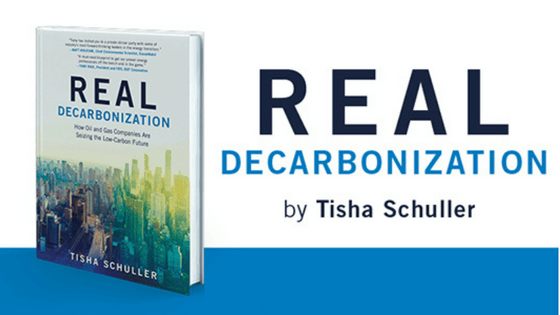It is not a given that any company will be around in 10 years. That’s why I’ve written my forthcoming book, Real Decarbonization ®: How Oil and Gas Companies Are Seizing the Low-Carbon Future.
Energy system decarbonization will happen better, faster, and more affordably with the oil and gas industry at the helm. I’ve had a career working in and with the oil and gas industry. And I have spent four years interviewing leaders in and around oil and gas to understand exactly what’s driving them to prioritize energy evolution work — the work I call “Real Decarbonization ®,” to distinguish it from the theoretical kind most pundits toss around. Those interviews (coupled with my regular work and additional research) informed the main argument of Real Decarbonization ®: Not only can the oil and gas industry lead the energy transition, we must.
You don’t need to agree. But you do need to develop a real decarbonization strategy. Let’s look at the fundamentals. At any given time, there are always a few constants for the energy industry:
- Consumers will continue to expect always on, abundant, and affordable energy.
- Production and delivery of energy will continue to become cleaner and more sustainable.
- Technology and innovation will be advancing.
So regardless of the state of politics or partisanship or passion, your company will be in a continuous state of evolution. I believe that voters, policymakers, and consumers will continue to prioritize addressing climate change as the thrust of that evolution. But you don’t have to agree with me to understand the urgency of developing a 10-year Real Decarbonization ® strategy — and to start developing one. Looking at the volatility around geopolitics, domestic partisanship, commodity prices, and macroeconomics tells us that oil and gas company leaders must be poised for change — a lot of it.
Why have I made 10 years the target for your Real Decarbonization ® strategy? Because it’s a time frame that provides balance between (1) enough time to make deep, structural changes that will transform the business and (2) a short enough runway to create accountability with employees, investors, and stakeholders who want to see a plan that connects aspiration with verifiable action.
Reason 1: Volatility and Transformation
The Number 1 reason you need a 10-year Real Decarbonization ® strategy: The world is volatile and transforming on an unprecedented scale. Its volatility and transformation provide you with the opportunity of a lifetime to act — to seize energy leadership. But if you don’t act, volatility and transformation will quickly present your company with a series of existential threats.
In a world where the only certainty is uncertainty, industry leaders own a few planning imperatives — all of which inform your 10-year Real Decarbonization ® strategy:
- Expect disruption in numerous forms: technology, the economy, politics, commodity pricing, the supply chain, geopolitics, public opinion, and generational and stakeholder expectations.
- Build a nimble organization responsive to changing conditions.
- Instill resilience in your company culture.
- Seek out likely new opportunities through envisioning and planning exercises.
- Play offense through proactive positioning in emerging arenas, such as hydrogen and renewable natural gas.
- Consider all the ways in which you can shape your company’s transformation through your engagement and actions.
For an energy company to be relevant in 10 years, it will have to have done more than survive the inevitable twists and turns. Your Real Decarbonization ® strategy is the central planning tool to ensuring your company’s continuing relevance.
Reason 2: The Drivers of Directional Change
The second reason you need a 10-year Real Decarbonization ® strategy? Four structural changes are driving directional climate action, and they are mobilizing — and will continue to mobilize — public interest in climate:
- Investor pressure. Now that everyone from BlackRock CEO Larry Fink to U.S. Treasury Secretary Janet Yellen to the Securities and Exchange Commission has equated climate risk with financial risk, responsible investors must begin prioritizing climate initiatives. A continuous flow of investor queries and proposed regulations reinforces how central climate analyses will be to company operations and disclosures. As one executive explained, “One of the most important outcomes of COP26 was this notion that net zero is an organizing principle for business.”
- Public sentiment. Stakeholders tend to interpret current events through their own political lenses. For example, in early 2022 I sat on a panel where one participant said the war in Ukraine was accelerating Germany’s permitting of wind facilities and another pointed out that Germany was turning coal-fired power back on. Very few people rewrite their climate analyses in the face of world events; many use world events to double down on their climate priorities.
- Generational change. Members of the millennial and Gen Z generations, even when politically conservative, often prioritize climate — and that prioritization is not going to change. The oldest millennials are now in their early 40s and continue to take leadership positions across finance, politics, community organizations, and business. They will dominate the population beyond 2050. Gen Z has now joined the millennials in the workforce; together these two cohorts will soon constitute most working adults.
- Company recruiting and retention. For the foreseeable future, oil and gas companies will be competing to both recruit and retain millennial and Gen Z talent. And increasingly, millennial and Gen Z workers will be under pressure from their peers to be a part of the climate solution (or at least part of the industries of the future!). Ask them and they will tell you: They want to see their companies leading in the decarbonizing energy future. And they will continue to pressure you to do so.
The drivers of directional change have resulted in changing expectations for oil and gas companies — from both within and without. And these changing expectations are intensifying.
Reason 3: Your Stakeholders’ Changing Expectations
In my last book, The Gamechanger’s Playbook, I advocated for companies to set aspirational decarbonization goals and to share those goals, as well as their vision and values, with their stakeholders. Explicit visionary leadership is mission-critical to changing the dynamics between our industry and a skeptical-to-hostile public. Since then, having an energy transition aspiration has become necessary for oil and gas companies — but also insufficient. Investors, customers, and employees now expect action, not just aspiration.
Your employees are an excellent audience to start with when you are evaluating the changing expectations of energy companies, because they are your frontline interface with other stakeholders. Now more than ever, employees find themselves acting as ambassadors for their companies and for the industry as a whole. Employees conveyed to the leaders I interviewed that, as employees, they wanted to participate in energy evolution leadership for a number of reasons:
- They feel pride in being a part of the climate solution and building the energy future, particularly those with grandchildren. They consider this work part of their legacy.
- They see energy transition jobs as the future of work, whether it’s the digitalization of existing operations or entirely new business ventures.
- They experience social pressure because they work for an oil and gas company. This is especially true of millennial and Gen Z employees, who often feel they have to justify working in our sector. Energy transition work allows them to tell a compelling story about our role in addressing climate.
- They want to be a part of finding the solutions to this monumental challenge of climate and decarbonization. This desire is particularly acute in engineering and technically trained staff.
Reason 4: Keeping Your Options Open
Even if a company has infinite innovation and investment resources, its leaders do not have any certainty that policymakers, regulators, and stakeholders will allow the permitting, construction, and operation of any new energy project. Building a 10-year Real Decarbonization ® plan now adds important risk mitigation to your company’s resilience strategy. This mitigation covers two primary arenas: (1) keeping development options open and (2) influencing relevant policy factors.
Let’s take hydrogen development as an option. Leaders within and outside of industry have generally assumed that future decarbonization projects (such as hydrogen) would be met with open arms by policymakers and stakeholders. This has not been the case.
Growing opposition to hydrogen development provides a stark warning to industry leaders. Academics and activists are working to turn the public and policymakers against decarbonization strategies that are perceived as benefiting the oil and gas industry. If we want to keep policy doors open for these strategies — for decarbonizing fuels, carbon capture and sequestration, and hydrogen — company leaders will need to assertively engage in the conversations about them immediately. Having a 10-year Real Decarbonization ® strategy is an essential framework to guide your research, partnerships, and engagement efforts.
Status Quo or 10-Year Energy Strategy?
Change is everywhere — and when change is everywhere, maintaining the status quo is not an option. As one leader conveyed, defending the status quo as your path forward is now the equivalent of saying, “As far as we can see into the future, we do not see any meaningful change.” Taking that stance turns your blind spot into blindness itself.
Building a 10-year Real Decarbonization ® strategy is necessary, because change is inevitable, and successful companies will plan and pivot. You’ll see when you read Real Decarbonization ® that many traditional oil and gas companies are already doing so.
I hope you enjoyed this excerpted text!
The Book and Your Real Decarbonization ® Strategy
Real Decarbonization ® drops November 10th — and is now available for e-book pre-order. Can’t wait until then to embark on your 10-year decarbonization journey? Reach out to schedule your consultation with Adamantine Energy. If this Real Decarbonization ® teaser was forwarded to you, subscribe here for future Both True content.
Here’s to getting real,
Tisha

